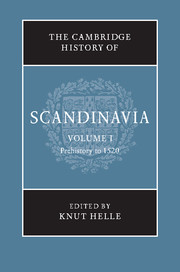Book contents
- Frontmatter
- Introduction
- PART I THE GEOGRAPHY AND PREHISTORY OF SCANDINAVIA
- 1 The Scandinavian Landscape and its Resources
- 2 The Stone and Bronze Ages
- 3 The Iron Age
- 4 Languages and ethnic groups
- PART II FROM VIKINGS TO KINGS
- PART III MATERIAL GROWTH (to c. 1350)
- PART IV THE HIGH MEDIEVAL KINGDOMS
- PART V HIGH AND LATE MEDIEVAL CULTURE
- PART VI LATE MEDIEVAL SOCIETY (c. 1350–1520)
- PART VII SCANDINAVIAN UNIONS (1319–1520)
- Conclusion
- Select bibliography: primary sources, general surveys and secondary works arranged by part
- Index
- Plate Section"
- References
4 - Languages and ethnic groups
from PART I - THE GEOGRAPHY AND PREHISTORY OF SCANDINAVIA
Published online by Cambridge University Press: 28 March 2008
- Frontmatter
- Introduction
- PART I THE GEOGRAPHY AND PREHISTORY OF SCANDINAVIA
- 1 The Scandinavian Landscape and its Resources
- 2 The Stone and Bronze Ages
- 3 The Iron Age
- 4 Languages and ethnic groups
- PART II FROM VIKINGS TO KINGS
- PART III MATERIAL GROWTH (to c. 1350)
- PART IV THE HIGH MEDIEVAL KINGDOMS
- PART V HIGH AND LATE MEDIEVAL CULTURE
- PART VI LATE MEDIEVAL SOCIETY (c. 1350–1520)
- PART VII SCANDINAVIAN UNIONS (1319–1520)
- Conclusion
- Select bibliography: primary sources, general surveys and secondary works arranged by part
- Index
- Plate Section"
- References
Summary
The linguistic prehistory of Scandinavia
For as far back as we can see, the languages of Scandinavia (Denmark, Finland, Norway, Sweden) have been either of Indo-European or Finno-Ugrian origin. At what point these types of speech first established themselves in the region is not wholly clear. Human activity can be demonstrated in Scandinavia as early as 10,000 BC, but it is unlikely, on comparative linguistic grounds apart from anything else, that the language or languages spoken by the earliest inhabitants were the ancestors of any of those spoken today.
Recent scholarly opinion (based on the meagre linguistic and archaeological evidence available) suggests that a group of Indo-European speakers moved into what is now Denmark, southern Sweden and southern Norway some time in the second half of the third millennium BC (cf. Chapter 2), probably spreading quickly into northern Germany (if the move there was not simultaneous). Such dating, however, is attended by many uncertainties and amounts to little more than educated guesswork. To add to the uncertainty, it has been argued by some that language change should be seen less in terms of mass migrations and more as a manifestation of cultural changes. Historically, it is of course of great importance to know how a particular form of language came to be in a certain area at a certain time. But from a purely linguistic point of view it can only be concluded that somehow and at some time, probably not later than 2000 BC, but possibly earlier, Indo-European speech came to southern Scandinavia and northern Germany.
Keywords
- Type
- Chapter
- Information
- The Cambridge History of Scandinavia , pp. 94 - 102Publisher: Cambridge University PressPrint publication year: 2003
References
- 1
- Cited by

